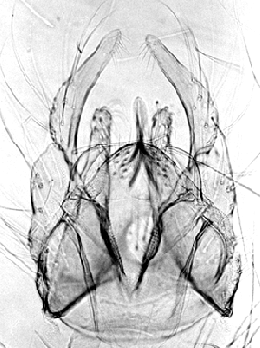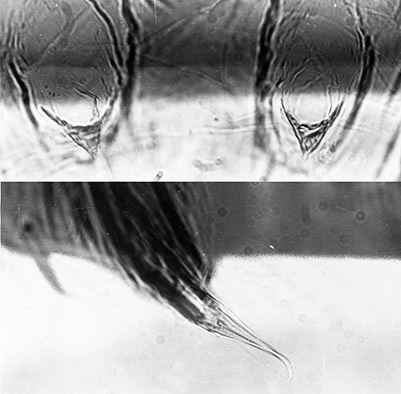Species 2u. C. nr. tuxis CurranThis species is closely related to C. species u.There is no BARCODE sequence matching that of this species currently in the BOLD database. Adult The adults and pupal exuviae of this species are in the Sublette Collection, now in the museum at the University of Minnesota, St. Paul.
Only the male terminalia can be given here.
Males:

Male terminalia of C. sp. 2u.About 5 setae within a patch on 9th tergite. Superior volsella closest to E(g)-type of Strenzke (1959). Gonostylus narrowing gently over posterior half. Pupa: Cephalic tubercles relatively small, postero-lateral spur with 1-2 long spines and possibly a shorter one.
 Fourth instar larva a medium sized (length 10.5-12.5 mm) plumosus-type. Lateral tubules about 239 (200-275 micron; anterior ventral tubules (1.31 mm) shorter on average than the posterior pair (1.33 mm). Anal tubules a single lobe, ventral pair probably longer (300-500 µm, cf. 355-540 µm), and 2-3.5 times longer than wide.
Gula broadly darkened but less in mid line (as in C. sp. u); frontoclypeus also darkened, generally as a thick stripe (also as in C. sp. u).
Mentum (Fig. c) with c1 tooth quite broad with short diverging sides (i.e. like a spear point) then rounded, c2 teeth quite well separated (type IB-III); 4th laterals generally reduced to about the level of the 5th laterals (type II-III).
Ventromental plates (Fig. d) about 3.4-3.5 times longer than deep; with about 48 (41-59) striae; VMR about 0.36 (0.35-0.38); separated by about 0.35-0.38 of mentum width. Pecten epipharyngis (a, below) with about 13 (10-17) relatively broad teeth (i.e. type B).
Premandible with outer tooth probably about same length as the inner tooth depending upon wear, inner tooth about 2.5 (2.3-3.3) times wider.
Antenna (Fig. b) with basal segment about 3.2 (2.7-3.8) times longer than wide; AR about 2.08 (1.86-2.41); RO from one third to one half up from base of segment; antennal segments (micron) 145 : 37 : 12 : 14 : 8. Segment A1 sometimes quite wide, but this may be due to being squashed onto slide during mounting.
Distance between antennal bases, about 161 (108-202) µm, less than that between S4 setae, 175 (142-197) µm; distance between S4 setae about 89 (83-92)% of FC width.
Mandible (Fig. e) with 3rd inner tooth lightly coloured and mostly partially separated (type I-IIB); about 21 (18-24) furrows on the outer surface near the base; and 12 (10-14) taeniae in Pecten mandibularis. Cytology: 4 relatively short polytene chromosomes with the thummi arm combination AB, CD, EF, G.
Arm G short and generally paired only at the virtually terminal nucleolus, often end-to-end. No nucleoli in the longer chromosomes.
Puff (groups 7-8) in arm B with distal dark bands near end of arm.
A small subterminal inversion in arm F was present in one specimen.
The available chromosome preparations are not clear because they are quite contracted, but it is possible the sequences are the same as those of C. species u, other than arm G. Found in large pools with mud bottoms at depth of about 60 cm.Found: Alberta - Huntington Hills, Calgary (51.08°N, 114.08°W).
Ontario - 4 ml e. Sudbury (44.88°N, 78.27°W).
Manitoba - 6.7 ml s. Erickson (50.48°N, 99.90°W). Molecular data:
MtCOI: Sequence has been obtained from larvae from Ontario and Manitoba but, as noted above, there is no matching sequence in BOLD or GenBank. [ Return to Index| Go to References ] |

